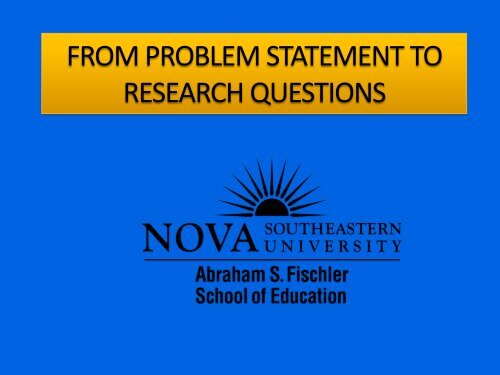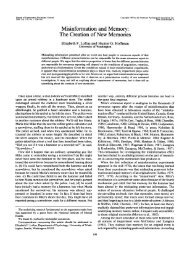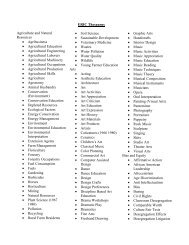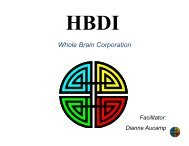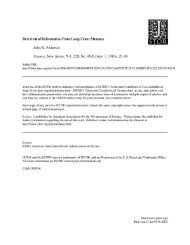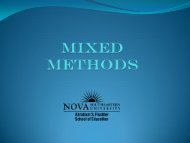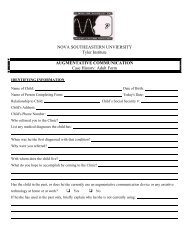FROM PROBLEM STATEMENT TO RESEARCH QUESTIONS - 1
FROM PROBLEM STATEMENT TO RESEARCH QUESTIONS - 1
FROM PROBLEM STATEMENT TO RESEARCH QUESTIONS - 1
Create successful ePaper yourself
Turn your PDF publications into a flip-book with our unique Google optimized e-Paper software.
<strong>FROM</strong> <strong>PROBLEM</strong> <strong>STATEMENT</strong> <strong>TO</strong><strong>RESEARCH</strong> <strong>QUESTIONS</strong>
Objectives• Understand and develop all of theChapter 1: Introduction sections.• Develop and articulate research questionsthat are related to the purpose of thestudy.
Chapter 1: IntroductionStatement of the ProblemThis should include (a) a clear statement that the problem exists, (b)evidence that supports the existence of the problem, (c) evidence of anexisting trend that has led to the problem, (d) definitions of majorconcepts and terms (this can be provided below in a subsection), (e) aclear description of the setting, (f) probable causes related to theproblem, and (g) a specific and feasible statement.The TopicThis is a brief description of the proposed area of study. Include at leasttwo sentences.The Research ProblemThis is an area of conflict, concern, or controversy (a gap between what iswanted and what is observed). Include the most relevant reference thatsupports the claim.
Chapter 1: Introduction (cont.)Background and JustificationThe evidence and relevance from the literature and published or archivaldata showing the problem exists. Include at least two references. Youshould also have a theoretical basis for the study.Deficiencies in the EvidenceInclude a brief discussion that details the area of need (in relation to theproblem) and the deficiency or lack of evidence in the literature.AudienceDiscuss who is affected and who benefits.Definition of TermsProvide complete scientific definitions and appropriate references ifnecessary. Include as many terms or variables as needed.Purpose of the StudyCreate a sentence that begins with “The purpose of this study is . . .”Clearly identify and define the central concepts or ideas of the study.
Example of the Flow of Ideas in theProblem StatementFlow of IdeasTopicResearchProblemJustificationfor ResearchProblemDeficiencies inthe EvidenceRelating theDiscussionto AudiencesSubjectarea•Concern or issue•A problem•Something thatneeds a solution•Evidence from theliterature•Evidence frompractical experienceAn Example•In this body ofevidence what ismissing or whatdo we need toknow more about?•How will addressingwhat we need to knowhelp researchers,educators, policymakers, and otherindividuals?EthicalissuesincollegesEthicalviolationsamong footballrecruiters•Gap in the literature•Reports of violationsDescriptionidentifying andcharacterizingviolations•Assessing violations•Helps recruiters developbetter ethical standards•Helps athletesunderstand ethical issues
The Topic• is introduced in the first paragraphs.• includes the general subject matter.• must be introduced so that the reader canrelate to it.
Topic Selection Considerations• Personal interest• Organizational support• Ethical issues• Relevance of the study• Contribution to the field• Time constraints• Breath and scope• Economic factors
Sources of Topic Selection• ERIC, PsycINFO, Medline• Journals, books, and dissertations in your field• Conferences, workshops, presentations• Recommendations about future research• Courses• Workplace• Expert consultations• Online library services
Why the Research Problem IsImportant• It establishes the importance of the topic.• It creates reader interest.• It focuses the reader’s attention on how thestudy will add to the literature.
Stating the Research Problem• State the problem in the opening paragraph(i.e., something that needs a solution)• Identify an issue– Research-based research problems– Practical problems• Reference the problem using the literature• Common pitfall: defining the problem basedon the solution
How the Problem Differs FromOther Parts of Research• A research problem is an educational issue orproblem in the study.• A research topic is the broad subject matterbeing addressed in a study.• A purpose is the major intent or objective ofthe study.• Research questions are those that theresearcher would like answered or addressedin the study.
Justifying the Importance of theResearch Problem• Justification based on what other researchershave found• Justification based on personal or workplaceexperiences• Justification based on the experiences thatothers have had in the workplace
Locating the Research Problem• Read the opening paragraphs of existingstudies for one or more of the following:– What is the issue or problem?– What controversy leads to the need for a study?– What concern is being addressed behind thestudy?– Is there a sentence such as, “The problem beingaddressed in this study is…”?
Determining Whether a ProblemShould Be Researched• Can you study the problem?– Do you have access to the research site?– Do you have the time, resources, and skills tocarry out the research?• Should you study the problem?– Does it advance knowledge?– Does it contribute to practice?
Determining Whether a ProblemShould Be Researched (cont.)• Will your study fill a gap or void in the existingliterature?• Will your study replicate a past study butexamine different participants and differentresearch sites?• Will your study extend past research orexamine the topic more thoroughly?• Will your study give voice to people not heard,silenced, or rejected in society?• Will your study inform practice?
How the Problem Differs FromOther Parts of Research• A research problem is an educational issue orproblem in the study.• A research topic is the broad subject matterbeing addressed in a study.• A purpose is the major intent or objective ofthe study.• Research questions are those that theresearcher would like answered or addressedin the study.
Identifying Deficiencies in theEvidence• What do we still need to know?• What else do we need to know to improvepractice?
Identify the AudienceAsk the following question: Who will profitfrom reading our study?• Other researchers• Practitioners• Policy makers• Special populations (e.g., parents)
Elements of a QuantitativePurpose Statement• A quantitative purpose statement identifies thevariables, their relationships, and the participantsand site for research• Guidelines for writing– Use a single sentence.– Use wording such as The purpose of this study . . . .– If using a theory, state the theory you plan to test.– Use quantitative words (e.g., “relate,” “compare,”“describe”) to describe the relationships betweenvariables.
Elements of a QuantitativePurpose Statement (cont.)• Guidelines for writing (cont.)– Independent variable (1st position in sentence)– Dependent variable (2nd position in sentence)– Control and/or mediating variable (3rd position insentence)– Research site– Participants
Quantitative Research Questions• Types of quantitative research questions– Describe results of your variables.– Compare two or more groups on the independentvariable in terms of the dependent variable.– Relate two or more variables.• Guidelines for writing– Pose a question.– Begin with “how,” “what,” or “why.”– Specify the independent, dependent, and mediatingor control variables.– Use the words describe, compare, or relate to indicatethe action or connection among the variables.– Indicate the participants and the research site for thestudy.
Designing Qualitative PurposeStatements and Research Questions• Understand how these statements andquestions differ from quantitative research.• Understand the role of a central phenomenonin qualitative research.• Understand qualitative research as anemerging process.
Differences Between Quantitative andQualitative Purpose Statements andResearch QuestionsQuantitative—more closedQualitative—more open ended1. Probable cause/effect(Why did it happen?)• Use of theories (Why did it happen inview of an explanation or theory?)• Assess differences and magnitude(How much happened?)(How many times did it happen?)(What were the differences amonggroups in what happened?)• Descriptive (What happened?)• Interpretive (What was the meaningto people of what happened?)• Process oriented (What happenedover time?)
Explaining or Predicting VariablesVersus Exploring or Understanding aCentral PhenomenonQuantitativeExplaining or PredictingVariablesQualitativeUnderstanding orExploring a CentralPhenomenonXYYThe independent variable (X)influences a dependentvariable (Y)In-depth understanding of Y;external forces shape and areshaped by Y
Elements of Qualitative PurposeStatement• A single sentence• A statement such as,“The purpose of this study . . . ”• The central phenomenon• A statement identifying the type of qualitativedesign• Qualitative words (e.g., “explore,” “understand,”“discover”)• The participants• The research site
Types of Qualitative ResearchQuestions• Central question is the overarching questionyou explore in the research study.• Subquestions divide the central question intosmaller, specific questions.– Issue subquestions: Narrow the focus of thecentral question into specific issues.– Procedural subquestions: Indicate the steps to beused in analyzing the data in a qualitative study.• Interview questions are asked during yourinterview and are based on your subquestions andcentral question.
Differences among the Topic,Problem, Purpose, and QuestionsGeneralTopicDistance learningSpecificResearchProblemPurposeStatementResearchQuestionLack of students in distanceclassesTo study why students do notattend distance education classes ata community collegeDoes the use of Web site technologyin the classroom deter studentsfrom enrolling in a distanceeducation class?
ExampleStatement of the ProblemThe TopicDistance education via online platforms is a rapidly growing method ofeducation delivery due to its convenience, wide reach, relatively low cost, andability to support the achievement of learning objectives. Whether the platformis Blackboard, WebCT, Moodle, Angel, or some other learning managementsystem, online education utilizes a variety of common learning tools includingdiscussion boards, drop boxes, automated testing, and wikis. Chief amongthese tools are live online sessions.The Research ProblemLive online sessions may be delivered in virtual classrooms from AdobeConnect, Elluminate, GoToMeeting, Wimba, or other software programs.Regardless of the software used, student attendance at live online sessions,especially optional ones, can be unpredictable at best. It is a commoncomplaint among the online faculty at a university in the south that many,oftentimes most, of their students do not attend the live online sessions. Thisstudy will address the problem of low student attendance at nonmandatoryvirtual classroom meetings in online college courses.
Background and JustificationOffir, Lev, and Bezalel (2008) found the interaction level in a synchronous class,also known as web conferencing, to be a significant factor in the effectivenessof the class. Other researchers describe “the power of a synchronous onlinesystem to empower students in conversation and expression (McBrien, Jones,& Cheng, 2009). However, if students do not attend, then they cannot interactnor express themselves.Deficiencies in the EvidenceAccording to Skylar (2009), “research concerning the use of newer multimediatechnologies, such as interactive synchronous web conferencing tools, is in itsinfancy and needs further and continued study” (p. 82). McBrien, Jones, andCheng (2009) stated that “more studies are needed to explore students’perceptions of the synchronous learning experience.” A variety of studies haveexplored the differences in functionalities of the various platforms (Kenning,2010; Lavolette, Venable, Gose, & Huang, 2010), but they did not get to theheart of why students do or do not attend.AudienceThis study will benefit college and university administrators who can create orrevise policies based upon the results. Administrators may even decide tochange virtual classroom providers. Faculty may benefit if results indicate achange is needed in their own practices. Finally, the study will benefit onlinestudents whose learning experiences will be improved by the findings.
Purpose of the StudyThe purpose of this qualitative study is to explore absenteeism fromnonmandatory synchronous sessions in the virtual learning environment,Wimba Classroom, by undergraduate and graduate students in online coursesat a southern university.Research QuestionsThe central question is, What are students’ attitudes regarding nonmandatorysynchronous sessions in Wimba at a southern university?The following are subquestions:1. What are students’ reasons for attending nonmandatory synchronoussessions in Wimba?2. What are students’ reasons for not attending nonmandatory synchronoussessions in Wimba?3. What actions could the university or its instructors take that would motivatestudents to increase their attendance at nonmandatory synchronous onlinesessions?
Student Examples• Topic• Research Problem• Purpose Statement• Research Question


